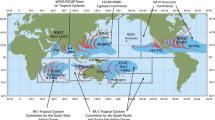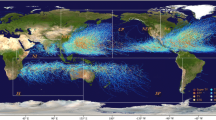Abstract
Even though the occurrence rate of tropical cyclones (TCs) is almost steady as reported in earlier studies, however, the intensity of TCs has shown a significant increase due to global warming. Gonu (2007) and Phet (2010) are examples of TCs, which affected the southern coasts of Iran. The first step in evaluating the effects of TC is the accuracy as well as the correctness of the wind field. For this purpose, the WRF and parametric models have been implemented for the wind field simulation, in the Makran coasts during the Gonu TC. QuikSCAT satellite data and coastal synoptic stations data have been used to evaluate the wind field results. The results indicated that the WRF model can successfully forecast the cyclone’s path and its outputs can be employed to forecast such weather hazards. Comparing the wind field results with satellite data, highlights the accuracy of the WRF model in the coastal areas. Modeling the wind field asymmetry due to the cyclone confinement and more realistic wind distribution, distinguishes the results of WRF model from other studied counterparts. In addition, a comparison of the wind field results with the synoptic data indicates that the WRF model results meet very good accuracy. Furthermore, the study of cyclone damage potential (CDP) index in the Gulf of Oman northern coasts shows that the WRF outcomes have a very high accuracy. This study highlights the capability of the ARW model in simulating the wind field, especially on the southern and southeastern coasts of Iran, which are affected by TCs.














Similar content being viewed by others
References
Alimohammadi M, Malakooti H (2018) Sensitivity of simulated cyclone Gonu intensity and track to variety of parameterizations: Advanced hurricane WRF model application. J Earth Syst Sci. https://doi.org/10.1007/s12040-018-0941-4
Alizadeh-Choobari O (2015) RETRACTED: Large-eddy simulation of the hurricane boundary layer: evaluation of the planetary boundary-layer parametrizations. Atmosph Res 154:73–88. https://doi.org/10.1016/j.atmosres.2014.11.004
Bell R, Strachan J, Vidale PL, Hodges K, Roberts M (2013) Response of tropical cyclones to idealized climate change experiments in a global high-resolution coupled general circulation model. J Clim 26:7966–7980
Cardone V, Cox A (2009) Tropical cyclone wind field forcing for surge models: critical issues and sensitivities. Natl Hazards 51:29–47
Cha D-H, Wang Y (2013) A dynamical initialization scheme for real-time forecasts of tropical cyclones using the WRF model. Mon Weather Rev 141:964–986
Czajkowski J, Done J (2014) As the wind blows? Understanding hurricane damages at the local level through a case study analysis. Weather Clim Soc 6:202–217
Das Y (2018) Parametric modeling of tropical cyclone wind fields in India. Nat Hazards 93:1049–1084
DHI (2017) MIKE 21 cyclone wind generation tool (scientific documentation). DHI Water and Environment company web. https://manuals.mikepoweredbydhi.help/2017/Coast_and_Sea/CycloneTool_Scientific_Doc.pdf. Accessed 1 June 2019
Dodla VB, Desamsetti S, Yerramilli A (2011) A comparison of HWRF, ARW and NMM models in Hurricane Katrina (2005) simulation. Int J Environ Res Public Health 8:2447–2469
Dunion JP, Landsea CW, Houston SH, Powell MD (2003) A reanalysis of the surface winds for Hurricane Donna of 1960. Mon Weather Rev 131:1992–2011
Durrant T, Greenslade D, Hemer M, Trenham C (2014) A global wave hindcast focussed on the Central and South Pacific. CAWCR Technical Report No. 070 CAWCR Publications Web. https://www.cawcr.gov.au/publications/CAWCR Technical Reports. Accessed 01 June 2019
Emanuel K (2005) Increasing destructiveness of tropical cyclones over the past 30 years. Nature 436:686–688
Green BW, Zhang F (2015) Numerical simulations of Hurricane Katrina (2005) in the turbulent gray zone. J Adv Model Earth Syst 7:142–161. https://doi.org/10.1002/2014ms000399
Guo Y, van de Lindt J (2019) Simulation of hurricane wind fields for community resilience applications: a data-driven approach using integrated asymmetric Holland models for inner and outer core regions. J Struct Eng 145:04019089
Hodges K, Cobb A, Vidale PL (2017) How well are tropical cyclones represented in reanalysis datasets? J Clim 30:5243–5264
Holland GJ (1980) An analytic model of the wind and pressure profiles in hurricanes. Month Weather Rev 108:1212–1218
Holland GJ, Belanger JI, Fritz A (2010) A revised model for radial profiles of hurricane winds. Mon Weather Rev 138:4393–4401
Holland GJ, Done JM, Douglas R, Saville GR, Ge M (2019) Global tropical cyclone damage potential. Hurricane risk. Springer, Berlin, pp 23–42
Kantha L (2006) Time to replace the Saffir-Simpson hurricane scale? Eos Trans Am Geophys Union 87:3–6
Krien Y et al (2018) Can we improve parametric cyclonic wind fields using recent satellite remote sensing data? Remote Sens 10:1963
Lin N, Chavas D (2012) On hurricane parametric wind and applications in storm surge modeling. J Geophys Res. https://doi.org/10.1029/2011JD017126
Mazaheri S, Kamranzad B, Hajivalie F (2013) Modification of 32 years ECMWF wind field using QuikSCAT data for wave hindcasting in Iranian Seas. J Coast Res 65:344–350
Mohanty U, Osuri KK, Routray A, Mohapatra M, Pattanayak S (2010) Simulation of Bay of Bengal tropical cyclones with WRF model: Impact of initial and boundary conditions. Mar Geodesy 33:294–314
Murakami H (2014) Tropical cyclones in reanalysis data sets. Geophys Res Lett 41:2133–2141
Nadimpalli R, Osuri KK, Mohanty U, Das AK, Kumar A, Sil S, Niyogi D (2020) Forecasting tropical cyclones in the Bay of Bengal using quasi-operational WRF and HWRF modeling systems: an assessment study. Meteorol Atmos Phys 132:1–17
Osuri KK, Mohanty U, Routray A, Kulkarni MA, Mohapatra M (2012a) Customization of WRF-ARW model with physical parameterization schemes for the simulation of tropical cyclones over North Indian Ocean. Nat Hazards 63:1337–1359
Osuri KK, Mohanty U, Routray A, Mohapatra M (2012b) The impact of satellite-derived wind data assimilation on track, intensity and structure of tropical cyclones over the North Indian Ocean International. J Remote Sens 33:1627–1652
Osuri KK, Mohanty U, Routray A, Mohapatra M, Niyogi D (2013) Real-time track prediction of tropical cyclones over the North Indian Ocean using the ARW model. J Appl Meteorol Climatol 52:2476–2492
Perlin N, De Szoeke SP, Chelton DB, Samelson RM, Skyllingstad ED, O’Neill LW (2014) Modeling the atmospheric boundary layer wind response to mesoscale sea surface temperature perturbations. Mon Weather Rev 142:4284–4307
Powell MD, Houston SH, Amat LR, Morisseau-Leroy N (1998) The HRD real-time hurricane wind analysis system. J Wind Eng Ind Aerodyn 77:53–64
Rakesh V, Singh R, Pal P, Joshi P (2009) Impacts of satellite-observed winds and total precipitable water on WRF short-range forecasts over the Indian region during the 2006 summer monsoon. Weather Forecast 24:1706–1731
Rathmann NM, Yang S, Kaas E (2014) Tropical cyclones in enhanced resolution CMIP5 experiments. Clim Dyn 42:665–681
Saket A, Etemad-Shahidi A, Moeini MH (2013) Evaluation of ECMWF wind data for wave hindcast in Chabahar zone. J Coast Res 65:380–386
Simpson RH, Riehl H (1981) The hurricane and its impact. Louisiana State University Press, Baton Rouge
Skamarock WC, Klemp JB, Dudhia J, Gill DO, Barker DM, Wang W, Powers JG (2008) A description of the Advanced Research WRF version 3. NCAR Technical note-475 STR.
Smith S (2010) Managing catastrophic risk: beyond cat bonds. Weather risk management: a guide for corporations, hedge funds and investors. Incisive financial Publishing Ltd, Harcourt, pp 199–213
Srinivas C, Bhaskar DR, Yesubabu V, Baskaran R, Venkatraman B (2013) Tropical cyclone predictions over the Bay of Bengal using the high-resolution Advanced Research Weather Research and Forecasting (ARW) model. Q J R Meteorol Soc 139:1810–1825
Tanemoto J, Ishihara T (2013) Prediction of tropical cyclone induced wind field by using mesoscale model and JMA best track. In: Paper presented at the The Eighth Asia-Pacific Conference on Wind Engineering, Chennai, India, pp 10–14
Thompson EF, Cardone VJ (1996) Practical modeling of hurricane surface wind fields. J Waterwa Port Coast Ocean Eng 122:195–205
Vickery PJ, Twisdale LA (1995) Wind-field and filling models for hurricane wind-speed predictions. J Struct Eng 121:1700–1709
Wang T, Yang Z, Wu W-C, Grear M (2018) A sensitivity analysis of the wind forcing effect on the accuracy of large-wave hindcasting. J Mar Sci Eng 6:139
Xue L, Li Y, Song L, Chen W, Wang B (2017) A WRF-based engineering wind field model for tropical cyclones and its applications. Natl Hazards 87:1735–1750
Young I (2017) A review of parametric descriptions of tropical cyclone wind-wave generation. Atmosphere 8:194. https://doi.org/10.3390/atmos8100194
Young I, Sobey R (1981) The numerical prediction of tropical cyclone wind-waves. Department of Civil and Systems Engineering, James Cook University of North Queensland, Research Bulletin No. CS20.
Zhai AR, Jiang JH (2014) Dependence of US hurricane economic loss on maximum wind speed and storm size. Environ Res Lett 9:064019
Author information
Authors and Affiliations
Corresponding author
Additional information
Responsible Editor: Silvia Trini Castelli.
Publisher's Note
Springer Nature remains neutral with regard to jurisdictional claims in published maps and institutional affiliations.
Rights and permissions
About this article
Cite this article
Mazyak, A.R., Shafieefar, M. Assessment of wind datasets on the tropical cyclones’ event (case study: Gonu tropical cyclone). Meteorol Atmos Phys 133, 739–757 (2021). https://doi.org/10.1007/s00703-020-00770-1
Received:
Accepted:
Published:
Issue Date:
DOI: https://doi.org/10.1007/s00703-020-00770-1




